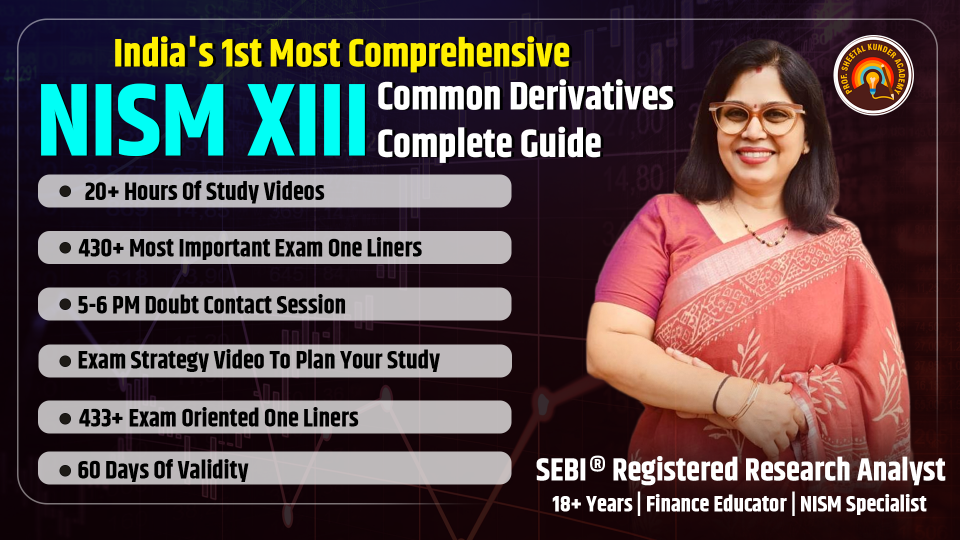There are no items in your cart
Add More
Add More
| Item Details | Price | ||
|---|---|---|---|
Tue Sep 30, 2025
Preparing for the NISM Series VIII: Equity Derivatives
Exam is both a challenge and an opportunity for finance professionals, aspiring traders, and students of the market. Unlike basic finance tests that only focus on theory, this exam evaluates how well you can connect concepts with practical realities. Questions are often framed around scenarios you might actually face in trading, which makes the preparation process intellectually rewarding. The subjects covered range from the basic functioning of futures and options to slightly advanced strategies like hedging with beta or constructing calendar spreads. What makes it interesting is that even simple-sounding topics like squaring off an open position carry significant weight when seen through the lens of real market operations. To truly succeed, one must not only memorize formulas but also develop an intuitive sense of how the derivatives ecosystem works and why each concept matters in ensuring the market’s fairness, efficiency, and liquidity.
Open Positions and Squaring Off
One of the first ideas to grasp in derivatives trading is the concept of open positions. Whenever you buy or sell a futures or options contract, you enter into an agreement that stays active until you close it. If you buy a Nifty futures contract and hold onto it, your exposure continues day after day until you eventually sell it to square off. Similarly, if you sell a contract, you must later buy it back. Until this is done, your trade remains “open,” and you’re exposed to potential profits or losses depending on market movement. Many beginners mistakenly believe that all trades automatically settle each evening, but that isn’t true. Positions roll over, accumulate daily mark-to-market adjustments, and only vanish when squared off or when the contract expires. In the exam, such distinctions are crucial. A small misinterpretation thinking that a position was closed when it wasn’t can lead to wrong answers. In actual markets, failing to monitor open positions can result in unexpected margin calls, reminding us that clarity in such fundamentals is not optional but absolutely essential.

Beta Management and Hedging
Risk management sits at the core of why derivatives exist. Beta management is a sophisticated yet practical technique where investors calculate how sensitive their portfolio is to movements in the market. A beta of 1.0 means the portfolio moves in line with the index, while a beta above 1.0 signals higher volatility. For instance, suppose you manage a ₹50 lakh portfolio with a beta of 1.3. This means your portfolio tends to move 30% more than the market. If the Nifty falls by 5%, your portfolio could decline by around 6.5%.
To protect against such losses, you can hedge using index futures. The hedge ratio Portfolio Value × Beta ÷ Contract Value—tells you how many contracts you must sell to balance the risk. In this case, if each Nifty contract is worth ₹2,50,000, you’ll need to sell 26 contracts. This calculation is not just an academic exercise; it mirrors what fund managers actually do when they expect a downturn. In the exam, you may face numerical questions that test your ability to quickly calculate the hedge ratio. Beyond numbers, however, lies the broader lesson: hedging isn’t about predicting the future; it’s about preparing for uncertainty. A portfolio without hedging is like a ship without lifeboats fine in calm waters but vulnerable when the storm hits.
Margins: The Safety Net of Derivatives
The derivatives market operates on leverage, and margins make that leverage possible while still maintaining discipline. When a trader buys or sells futures, they are not required to pay the entire value of the contract upfront. Instead, they deposit a fraction—known as margin with the broker, who in turn deposits it with the exchange. This ensures both parties have “skin in the game” and reduces the chance of default. Margins typically include an initial margin and a mark-to-market (MTM) margin.
The initial margin is like a security deposit, while the MTM margin adjusts daily based on price movements. For example, if you buy a Bank Nifty contract at 45,000 and it falls to 44,800, the 200-point loss multiplied by the lot size (say 25) equals ₹5,000, which will be deducted from your margin account. If your balance falls below the maintenance requirement, you’ll receive a margin call to top it up. Many exam questions test the function of margins because they are central to the market’s smooth functioning. Without margins, speculation would spiral out of control, defaults would rise, and confidence in the system would collapse. In short, margins are not just a technicality they are the invisible threads holding the derivatives market together.
Calendar Spreads with Bank Nifty
A calendar spread might sound complex at first, but the logic is straightforward: you simultaneously buy and sell futures contracts of the same underlying asset with different expiry dates. Traders often use this to benefit from differences in time value or expectations of volatility.
Consider this: you sell a January Bank Nifty contract at 45,000 while buying a February contract at 45,100. When January expires, your short position is automatically squared off, and only the February contract remains open. Depending on how February’s prices move, you may profit from the spread between the two contracts. Unlike outright long or short positions, spreads reduce risk because gains in one leg often offset losses in the other. The NISM exam loves to test candidates on whether they can recognize such positions in case-based questions.
The takeaway? Calendar spreads are not about betting wildly on market direction but about exploiting subtle differences in pricing across time. In real markets, traders use them to manage exposure, reduce risk, and sometimes to capture small but consistent returns.
The Concept of Short Selling
Short selling often feels counterintuitive because it goes against the everyday idea of ownership. You are essentially selling something you don’t own, with the promise of buying it later. In derivatives, this is a normal and widely accepted practice. Imagine Reliance Industries trading at ₹2,800. You believe this is overvalued, so you sell it short. If the stock price falls to ₹2,700, you buy it back and pocket the difference, earning ₹100 per share. The brilliance of short selling is that it allows traders to profit in falling markets, making derivatives far more flexible than traditional investments.
But the risk is equally high if the price rises instead, your losses can be unlimited. The exam may present scenarios where you have to identify whether a trader is engaged in short selling or normal buying. The golden rule here is: every short sale must eventually be covered by a buy transaction. This cycle sell first, buy later—is the defining feature of short selling. In practice, it reflects one of the most powerful tools in a trader’s arsenal, but also one of the riskiest if misused.
Understanding Cost of Carry
Why are futures prices often higher than spot prices? The answer lies in the cost of carry. Holding an asset over time comes with costs—interest on borrowed money, insurance, storage, or even forgone opportunities. For equities, the primary elements are financing costs (the risk-free interest rate) minus any dividends expected during the holding period. Suppose the spot price of a stock is ₹1,000, the risk-free rate is 6% annually, and the dividend yield is 2%. For a three-month contract, the futures price would be calculated as ₹1,000 × (1 + 0.06 − 0.02)^(0.25), which roughly equals ₹1,010. That ₹10 difference isn’t random it reflects the cost of carry. In commodities like gold or crude oil, additional costs like storage and transportation are factored in.
For exam purposes, this topic is heavily tested because it ties directly into pricing models. More importantly, understanding the cost of carry helps traders know whether futures are fairly priced or if arbitrage opportunities exist. In practice, professional arbitrageurs constantly monitor these gaps and act immediately when mispricing occurs, ensuring the market remains efficient.
Liquidity and the Role of Speculators
Liquidity is the oxygen of financial markets. It ensures that traders can enter and exit positions quickly without causing drastic price changes. In derivatives, liquidity is especially vital because contracts have expiries and rollovers. Who provides this liquidity? Primarily speculators. While hedgers are focused on protecting themselves, speculators willingly take risks, buy and sell in large volumes, and ensure there are always counterparties available. This constant activity tightens bid-ask spreads, improves price discovery, and keeps the market efficient. For example, if only a handful of hedgers were trading, you might have to wait hours or days to find a counterparty, making the market inefficient. But thanks to speculators, liquidity flows freely. The exam often asks conceptual questions like “Why is liquidity considered the lifeblood of the market?” or “What role do speculators play in maintaining liquidity?” The answer lies in recognizing that without speculators, the market would lose its vibrancy and efficiency.
Conclusion
The journey to mastering equity derivatives isn’t just about clearing the NISM Series VIII exam, though that’s certainly the immediate goal for many. It’s about building a foundation of knowledge that will serve throughout one’s career in finance or trading. Concepts such as open positions, hedging with beta, margin requirements, calendar spreads, short selling, cost of carry, and liquidity form the backbone of derivatives trading. They may seem abstract at first, but as you dive deeper, their practical relevance becomes undeniable. The exam tests these areas not to confuse you but to ensure you understand the mechanics of markets that influence millions of investors daily. By internalizing these lessons, you not only increase your chances of passing the exam with confidence but also gain a sharper perspective on how financial markets function at a deeper level. In many ways, studying for this exam is like training for the real battlefield of trading you sharpen your tools, test your thinking, and prepare yourself for both risks and opportunities ahead.

Prof. Sheetal Kunder
SEBI® Research Analyst. Registration No. INH000013800 M.Com, M.Phil, B.Ed, PGDFM, Teaching Diploma (in Accounting & Finance) from Cambridge International Examination, UK. Various NISM Certification Holders. Ex-BSE Institute Faculty. 18 years of extensive experience in Accounting & Finance. Faculty Development Programs and Management Development Programs at the PAN India level to create awareness about the emerging trends in the Indian Capital Market and counsel hundreds of students in career choices in the finance area